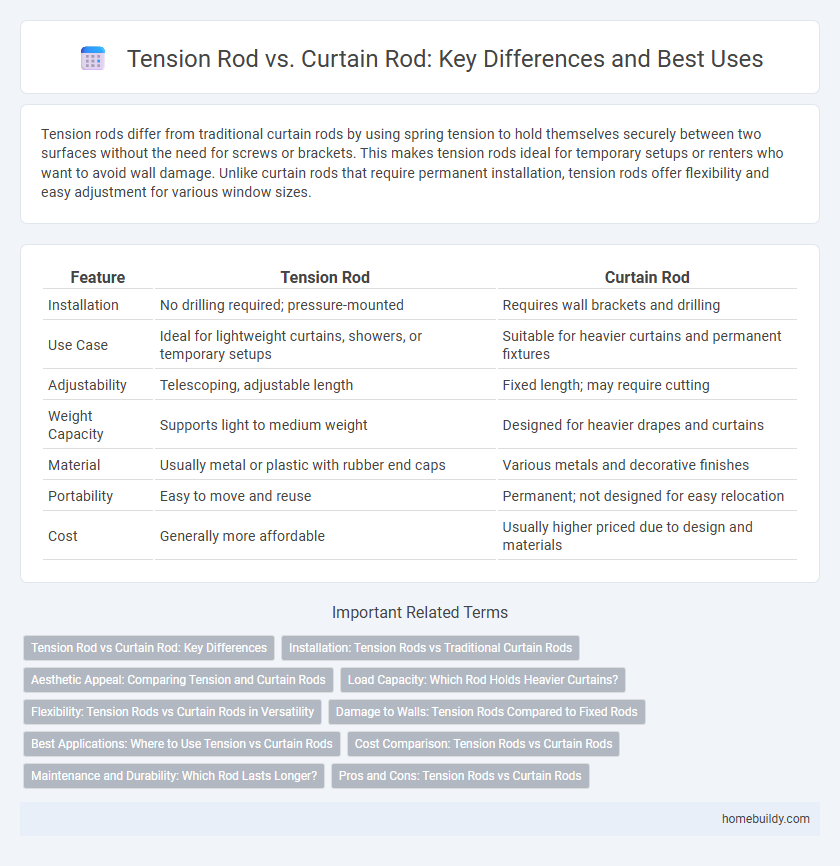Tension rods differ from traditional curtain rods by using spring tension to hold themselves securely between two surfaces without the need for screws or brackets. This makes tension rods ideal for temporary setups or renters who want to avoid wall damage. Unlike curtain rods that require permanent installation, tension rods offer flexibility and easy adjustment for various window sizes.
Table of Comparison
| Feature | Tension Rod | Curtain Rod |
|---|---|---|
| Installation | No drilling required; pressure-mounted | Requires wall brackets and drilling |
| Use Case | Ideal for lightweight curtains, showers, or temporary setups | Suitable for heavier curtains and permanent fixtures |
| Adjustability | Telescoping, adjustable length | Fixed length; may require cutting |
| Weight Capacity | Supports light to medium weight | Designed for heavier drapes and curtains |
| Material | Usually metal or plastic with rubber end caps | Various metals and decorative finishes |
| Portability | Easy to move and reuse | Permanent; not designed for easy relocation |
| Cost | Generally more affordable | Usually higher priced due to design and materials |
Tension Rod vs Curtain Rod: Key Differences
Tension rods utilize adjustable spring mechanisms to fit securely between two surfaces without hardware, ideal for lightweight curtains and temporary setups. Curtain rods typically require wall brackets or finials for installation, providing stronger support for heavier drapes and decorative finishes. The primary differences lie in installation method, load capacity, and versatility, with tension rods offering easy placement and removal, while curtain rods accommodate more robust and permanent curtain designs.
Installation: Tension Rods vs Traditional Curtain Rods
Tension rods offer a tool-free installation process, relying on adjustable spring tension to fit snugly between two surfaces without drilling or hardware, ideal for temporary or rental spaces. Traditional curtain rods require mounting brackets, screws, and anchors, necessitating precise measurements and wall penetration for secure attachment. The ease of installation with tension rods reduces wall damage and allows for quick repositioning, whereas traditional rods provide more stability for heavier curtains but involve more manual effort and potential surface alteration.
Aesthetic Appeal: Comparing Tension and Curtain Rods
Tension rods provide a sleek, minimalist aesthetic with their slim profiles and invisible mounting, enhancing modern and contemporary interiors without hardware intrusion. Curtain rods offer diverse decorative finials and finishes, adding character and style that complement traditional and ornate room designs. The choice between tension and curtain rods ultimately depends on the desired visual impact and room aesthetics.
Load Capacity: Which Rod Holds Heavier Curtains?
Tension rods rely on adjustable spring mechanisms to create pressure between two surfaces, which limits their load capacity compared to curtain rods that are mounted with brackets or screws for greater stability. Curtain rods, especially those made of metal and installed securely, can support heavier and thicker curtains without bending or slipping. For heavy drapes or frequent use, a fixed curtain rod provides superior strength and reliability over tension rods.
Flexibility: Tension Rods vs Curtain Rods in Versatility
Tension rods offer superior flexibility due to their adjustable length and easy installation, making them ideal for a variety of window sizes and unconventional spaces. Curtain rods, often fixed in length and requiring brackets, provide less adaptability but can support heavier drapes and elaborate hardware. Choosing tension rods enhances versatility for renters or temporary setups, while curtain rods suit permanent installations with a focus on durability and style.
Damage to Walls: Tension Rods Compared to Fixed Rods
Tension rods cause less damage to walls compared to fixed curtain rods since they rely on compression to stay in place without the need for drilling holes or mounting brackets. Fixed rods require screws or anchors, which can leave permanent holes and weaken wall surfaces over time. When minimizing wall damage is a priority, tension rods offer a non-invasive and easily removable solution.
Best Applications: Where to Use Tension vs Curtain Rods
Tension rods are ideal for temporary or rental spaces, providing easy installation without drilling, perfect for lightweight curtains or shower curtains where flexibility is needed. Curtain rods are better suited for permanent installations requiring sturdy support for heavier drapes or decorative curtains, often mounted directly into walls or window frames. Choose tension rods for convenience and adjustability, while curtain rods are preferable for durability and aesthetic customization in more permanent settings.
Cost Comparison: Tension Rods vs Curtain Rods
Tension rods generally cost less than traditional curtain rods due to their simpler design and ease of installation, with prices ranging from $10 to $30 compared to curtain rods which can vary from $20 to $100 or more depending on material and customization. Tension rods eliminate the need for drilling or hardware, reducing both equipment costs and labor fees typically associated with curtain rods. For budget-conscious consumers, tension rods offer a cost-effective solution without sacrificing functionality or style.
Maintenance and Durability: Which Rod Lasts Longer?
Tension rods, designed with adjustable spring mechanisms, require regular inspection to ensure the internal tension remains effective, preventing sagging or failure over time. Curtain rods, typically mounted with brackets and made from metals like aluminum or steel, often offer greater structural durability and less frequent maintenance due to their fixed installation. Overall, curtain rods tend to last longer given their sturdier construction and reduced mechanical stress compared to tension rods.
Pros and Cons: Tension Rods vs Curtain Rods
Tension rods offer easy, tool-free installation and damage-free mounting by relying on adjustable spring tension, ideal for renters or temporary setups. Curtain rods provide a sturdier, more permanent solution capable of supporting heavier drapes and decorative finials but require drilling and wall anchors, potentially causing wall damage. Tension rods can struggle with heavy fabrics or wide windows, while curtain rods offer greater customization in length and style but involve more installation effort.
Tension rod vs Curtain rod Infographic

 homebuildy.com
homebuildy.com